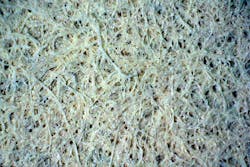TU Munich builds random laser from cellulose paper
A paper in Advanced Optical Materials describes how a team led by Professor Cordt Zollfrank from the Technical University of Munich (TU Munich or TUM), working with physicists from the University of Rome in Italy, built the first controllable random laser based on cellulose paper. The team thereby showed how naturally occurring structures can be adapted for technical applications. Hence, materials no longer need to be artificially outfitted with disordered structures, utilizing naturally occurring ones instead.
RELATED ARTICLE: Wood-derived cellulose nanocrystals form iridescent film for textile and security applications
Material synthesis that is inspired by biology is an area of research at TUM's Chair of Biogenic Polymers at the Straubing Center of Science. It uses models from nature and biogenic materials—biomimetics—to develop new materials and technologies. The basic study by the joint team from Straubing and Rome succeeded in "using a biological structure as a template for a technical random laser," according to scientist Daniel Van Opdenbosch.
Two components are necessary for a laser: first, a medium which amplifies light and second, a structure that retains the light in the medium. A classic laser uses mirrors to order and shine light in a single direction in a targeted, uniform fashion. This also takes place uniformly in the microscopic structure of a random laser, but in different directions. Although the development of the random laser is still in its infancy, in the future it could result in lower-cost production. This is because random lasers have the advantage that they are direction-independent and function with multiple colors, just to name a few benefits.
"The prerequisite for a random laser is a defined degree of structural chaos on the interior," Van Opdenbosch explained. The light in a random laser is therefore scattered at all manner of angles along random paths, which are determined by an irregular structure in the interior of the medium. The team led by Professor Zollfrank from the Chair of Biogenic Polymers in Straubing used conventional laboratory filter paper as a structural template. "Due to its long fibers and the resulting stable structure, we deemed it to be suitable for this purpose," said Van Opdenbosch.
In the laboratory, the paper was impregnated with tetraethyl orthotitanate, an organometallic compound. When it is dried and the cellulose burned off at 500 degrees Celsius, it leaves behind the ceramic titanium dioxide as residue—the same substance generally used in sunblock to provide protection from the sun. "This effect in sunblock is based on titanium dioxide's strong light scattering effect," said Van Opdenbosch, "which we also utilized for our random laser." And "our laser is 'random' because the light which is scattered in different directions due to the biogenic structure of the laboratory filter paper can also be scattered in the opposite direction," he added, explaining the principle.
However, the light waves can still be controlled despite their random nature, as the team led by Claudio Conti of the Institute for Complex Systems in Rome discovered, with whom Daniel Van Opdenbosch and Cordt Zollfrank collaborated. With the help of a spectrometer, they were able to differentiate the various laser wavelengths generated in the material and localize them separately from one another.
Van Opdenbosch described the procedure: "The test setup used to map the samples consisted of a green laser whose energy could be adjusted, microscope lenses, and a mobile table which allowed the sample to be moved past. That way, our colleagues were able to determine that at different energy levels, different areas of the material radiate different laser waves." In light of this analysis, it is possible to configure the laser in any number of ways and to determine the direction and intensity of its radiation.
SOURCE: TU Munich; https://www.tum.de/en/about-tum/news/press-releases/short/article/33517/
About the Author

Gail Overton
Senior Editor (2004-2020)
Gail has more than 30 years of engineering, marketing, product management, and editorial experience in the photonics and optical communications industry. Before joining the staff at Laser Focus World in 2004, she held many product management and product marketing roles in the fiber-optics industry, most notably at Hughes (El Segundo, CA), GTE Labs (Waltham, MA), Corning (Corning, NY), Photon Kinetics (Beaverton, OR), and Newport Corporation (Irvine, CA). During her marketing career, Gail published articles in WDM Solutions and Sensors magazine and traveled internationally to conduct product and sales training. Gail received her BS degree in physics, with an emphasis in optics, from San Diego State University in San Diego, CA in May 1986.
